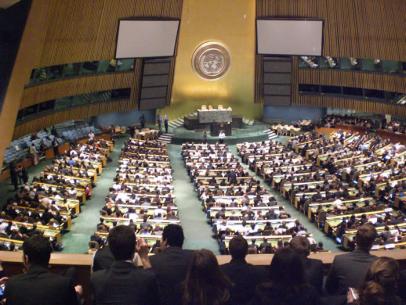"Why the NPT needs more transparency by the nuclear weapon states"

The UN General Assembly (photo courtesy of the UN)
The Simons Foundation's Peace Leader, Henrik Salander, and Senior Fellow, Paul Meyer, were members of the International Panel on Fissile Material (IPFM) and have prepared the following commentary with their IPFM colleague Zia Mian.
Excerpt: A growing accountability crisis is likely to be a core concern when the 189 states party to the Nuclear Non-Proliferation Treaty (NPT) meet for a Review Conference in New York in April and May. At the heart of the accountability issue is a simple question: How can the signatories to the NPT, and the world, be confident that there is real progress toward meeting the disarmament goals of the treaty?
The NPT entered into force 45 years ago, and one of the treaty’s core obligations is nuclear disarmament, as set out in its Article VI. The NPT’s nuclear-weapon states (the US, UK, France, Russia, and China) have insisted they are making progress toward this goal. Despite this claim, an estimated 16,000 nuclear weapons remain today, and there are no talks on an international treaty to ban and eliminate nuclear weapons.
Please visit the Bulletin of the Atomic Scientists at the link below for the complete article.
"Why the NPT needs more transparency by the nuclear weapon states"
By Paul Meyer, Henrik Salander, and Zia Mian
Published by the Bulletin of the Atomic Scientists
April 8, 2015
Amb. (Ret'd) Henrik Salander is a former Swedish diplomat who has played a pivotal role in the international debate over nuclear disarmament and is one of The Simons Foundation's Peace Leaders.
Amb. (Ret'd) Paul Meyer is a Fellow in International Security, Centre for Dialogue, Simon Fraser University in Vancouver, Canada, and Senior Fellow, The Simons Foundation.